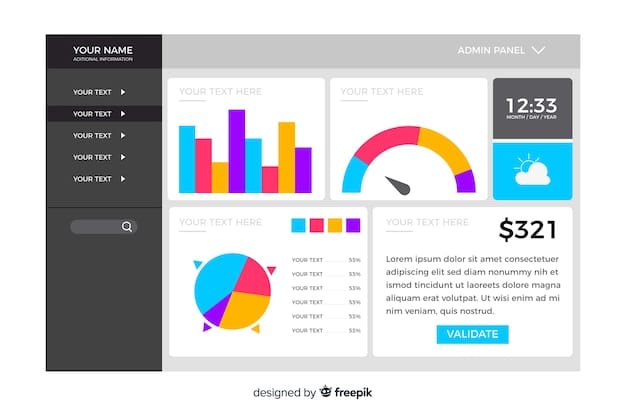Mobile-First Indexing: Is Your US E-commerce Site Ready for 2025?

Mobile-First Indexing, crucial for US e-commerce sites, prioritizes the mobile version of a website for Google’s indexing and ranking, ensuring optimal search visibility and user experience, especially with Google’s algorithm update in 2025.
Is your US e-commerce site optimized for mobile? With Google’s 2025 algorithm update looming, **mobile-first indexing** is no longer optional – it’s critical. Make sure your business is ready for this shift.
Understanding Google’s Mobile-First Indexing
Google’s mobile-first indexing means that the search engine primarily uses the mobile version of a website for indexing and ranking. This shift reflects the increasing dominance of mobile browsing and the need to provide users with the best possible mobile experience. For US e-commerce sites, understanding this concept is the first step towards preparing for the future of search.
Why Mobile-First Indexing Matters for E-commerce
The rise of mobile shopping has made mobile-first indexing critical. If your e-commerce site isn’t optimized for mobile, you risk losing visibility in search results and providing a poor user experience, leading to lost sales.
Key Differences Between Mobile and Desktop Indexing
Mobile indexing prioritizes the mobile version of your site, while desktop indexing looks at the desktop version. These differences impact everything from website design to content strategy. The mobile version dictates, so make sure you have a fast and responsive design.
- Mobile Experience: Focus on speed, usability, and a streamlined purchase process.
- Content Prioritization: Ensure important content is readily available on mobile.
- Technical SEO: Optimize for mobile-specific issues like AMP and responsive design.
Understanding and adapting to these differences is vital for success in the era of mobile-first indexing. Mobile-first indexing is no longer simply an option – it’s now critical to how Google discovers, analyzes, and ranks your content. This means that if your site doesn’t offer a functional mobile experience, it may not get indexed or ranked appropriately in the results. This is why it matters so much — especially to e-commerce vendors that are trying to bring on customers.
Assessing Your Current Mobile Readiness
Before making any changes, it’s important to assess your current mobile readiness. This involves evaluating your website’s mobile performance, user experience, and technical SEO. A thorough assessment will provide valuable insights into the areas that need improvement to achieve a stronger online presence.

Using Google’s Mobile-Friendly Test
Google’s Mobile-Friendly Test is a valuable tool for assessing your site’s mobile readiness. It identifies usability issues and provides recommendations for improvement, giving you a clear roadmap for optimization.
Analyzing Mobile Page Speed
Mobile page speed is a critical factor in user experience and search ranking. Slow loading times can lead to high bounce rates and lost sales, so it’s important to identify and address any speed-related issues.
- Compress Images: Reduce file sizes without sacrificing quality.
- Leverage Browser Caching: Store static resources to improve loading times on repeat visits.
- Minify CSS and JavaScript: Remove unnecessary characters to reduce file sizes.
By thoroughly assessing your current mobile readiness and addressing any identified issues, you can ensure that your site is prepared for mobile-first indexing and beyond. This assessment is super important because, in the end, you want customers to buy your products!
Optimizing Your Website for Mobile-First Indexing
Optimizing your website for mobile-first indexing involves a range of strategies designed to improve mobile performance, user experience, and technical SEO. Content optimization, responsive design, and structured data markup are some of the key elements.
Content Optimization for Mobile
Mobile content needs to be concise, engaging, and easy to consume. Optimize your content for smaller screens by using shorter paragraphs, bullet points, and clear headings.
Implementing Responsive Design
Responsive design ensures that your website adapts seamlessly to different screen sizes and devices. This provides a consistent user experience across all devices, which is essential for mobile-first indexing.
Using Structured Data Markup
Structured data markup helps search engines understand the content on your pages. Implement structured data to provide Google with more information about your products, services, and business.

By implementing these optimization strategies, you can improve your website’s mobile performance, user experience, and search ranking, preparing it for the challenges and opportunities of mobile-first indexing. Keep in mind that the goal is to provide a simplified experience for mobile. Some things that are great on a desktop are simply too cumbersome for a phone.
Technical SEO Considerations for Mobile
Technical SEO plays a crucial role in mobile-first indexing. Addressing mobile-specific issues such as mobile sitemaps, robots.txt files, and canonical tags is essential for ensuring that the mobile version of your site is properly indexed. Mobile-specific issues are often a common mistake people make when trying to set up the proper implementation.
Creating a Mobile Sitemap
A mobile sitemap helps search engines discover and index the pages on your mobile site. Submit your mobile sitemap to Google Search Console to ensure that your mobile pages are properly indexed.
Configuring Robots.txt for Mobile
The robots.txt file controls which pages search engines can crawl. Ensure that your robots.txt file allows search engines to crawl the important pages on your mobile site.
Using Canonical Tags Correctly
Canonical tags tell search engines which version of a page is the preferred one. Use canonical tags correctly to avoid duplicate content issues between your mobile and desktop sites.
- Mobile Sitemap Submission: Ensure Google can easily find and index your mobile pages.
- Robots.txt Verification: Prevent unintentional blocking of important mobile content.
- Canonical Tag Implementation: Avoid duplicate content penalties by specifying preferred versions.
By addressing these technical SEO considerations, you can ensure that your mobile site is properly crawled, indexed, and ranked by search engines, improving your overall search visibility and performance in mobile-first indexing. In general, all the SEO principles that work for desktop SEO also matter on mobile.
Mobile User Experience (UX) Best Practices
Mobile user experience (UX) is a critical factor in the success of any e-commerce site. Prioritizing usability, accessibility, and mobile-friendly navigation is essential for providing a positive experience for mobile users, driving engagement, and improving conversion rates.
Prioritizing Mobile Usability
Mobile usability focuses on making it easy for users to find what they need and complete their desired actions on your mobile site. Streamline navigation, use clear calls-to-action, and minimize form fields to improve usability.
Ensuring Mobile Accessibility
Mobile accessibility ensures that your site is usable by people with disabilities. Use semantic HTML, provide alternative text for images, and ensure that your site is keyboard-accessible to improve accessibility.
Creating Mobile-Friendly Navigation
Mobile-friendly navigation makes it easy for users to find their way around your site. Use a clear and concise menu, provide breadcrumb navigation, and ensure that your site is easy to navigate on small screens.
By prioritizing mobile UX best practices, you can provide a positive and engaging experience for mobile users, driving engagement, improving conversion rates, and achieving success in the era of mobile-first indexing. After all, people will buy your product if the mobile navigation is easy!
Monitoring and Maintaining Mobile Performance
Monitoring and maintaining mobile performance is an ongoing process. It allows you to verify the effectiveness of implemented strategies and take necessary action. Continuously monitoring your analytics is a key aspect that you can do to ensure that you’re able to make the necessary changes.
Tracking Key Mobile Metrics
Tracking key mobile metrics such as traffic, bounce rate, and conversion rate provides valuable insights into the performance of your mobile site. Use Google Analytics to monitor these metrics and identify areas that need improvement, thus resulting in more effective marketing efforts.
Regularly Auditing Your Mobile Site
Regularly auditing your mobile site helps you identify and address any technical issues or usability flaws that may be impacting performance. Use tools like Google PageSpeed Insights and the Mobile-Friendly Test to audit your site and identify areas for improvement.
- Traffic: Monitor the number of visits to your mobile site over time.
- Bounce Rate: Track the percentage of users who leave your site after viewing only one page.
- Conversion Rate: Measure the percentage of users who complete a desired action, such as making a purchase.
By continuously monitoring and maintaining your mobile performance, you can ensure that your site is optimized. By making positive and effective changes, you can achieve better search results. This also results in an improvement in user experience. Prepare your website and guarantee your success in the era of mobile-first indexing!
| Key Point | Brief Description |
|---|---|
| 📱 Mobile-First Indexing Importance | Google primarily uses the mobile version of websites for indexing and ranking. |
| 🚀 Optimizing for Mobile Speed | Faster mobile page speeds improve user experience and search rankings. |
| ✅ Technical SEO Checks | Ensure mobile sitemaps and robots.txt are properly configured. |
| 🖐️ UX for Mobile | Navigation should be streamlined and prioritize useability for mobile users. |
Frequently Asked Questions
▼
It is when Google predominantly uses the mobile version of a website for ranking purposes. Websites can prepare themselves for mobile-first indexing by improving the mobile UX and speed. When done correctly, this can result in more customers through better optimization.
▼
Google offers a free mobile-friendly test tool. This tool analyzes your site’s mobile usability and provides suggestions for fixes. Google’s algorithm favors pages that are ranked as mobile-friendly. Use this tool regularly to measure your page’s success.
▼
A **mobile-first indexing** website is usually responsive, fast, and has a simple navigation structure. It should have elements like compressed images, browser caching, and minified CSS. This can improve user experience and search engine ranks.
▼
Google factors page-speed into the rankability of the website. It is a fundamental aspect of **mobile-first indexing**. A slow website makes using your site very frustrating, and often, customers will simply go to one of your competitors to buy your product.
▼
Ensure responsive design, improve page speed, optimize images, and use structured data markup. Make sure that your site is usable by all customers, including those with disabilities. Implement these actions carefully.
Conclusion
As Google’s 2025 algorithm update approaches, preparing your US e-commerce site for **mobile-first indexing** is essential for maintaining and growing your online presence. By understanding the importance of mobile-first indexing, assessing your current mobile readiness, optimizing your website, addressing technical SEO considerations, prioritizing mobile UX best practices, and continuously monitoring your mobile performance, you can ensure that your site is well-positioned for success in the mobile-first era.





